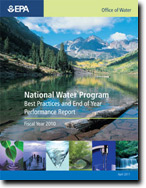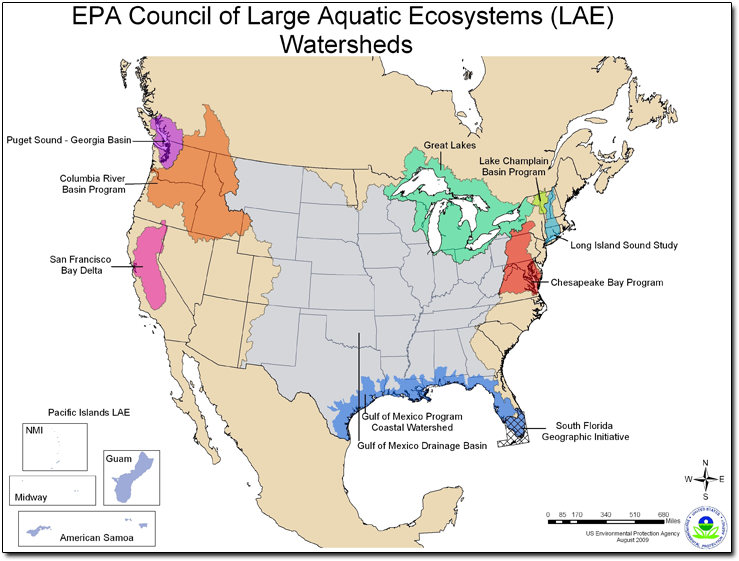Water: Programs
Large Aquatic Ecosystems
| Oceans, Coasts, Estuaries & Beaches Quick Finder | |||
|---|---|---|---|
| Oceans, Coasts, & Estuaries Home Coastal Watershed Protection | Marine Pollution Prevention Monitoring and Assessment | Ocean & Coastal Partnerships Frequently Asked Questions | Coasts for Kids |
About Large Aquatic Ecosystems (LAEs)
What Are Large Aquatic Ecosystems?
A large aquatic ecosystem (LAE) is comprised of multiple small watersheds and water resources within a large geographic area. It includes lakes, rivers, wetlands, estuaries, and the airshed and watershed surrounding these water bodies. The living resources found within the large ecosystems include fish, birds, plants and other wildlife, providing a significant portion of the world's food supply. LAEs supply ecological services such as groundwater recharge, flood management, air purification, nutrient cycling, and wildlife habitat. In addition, LAEs provide considerable recreation and tourism services, particularly within coastal communities. These industries, along with others such as manufacturing, shipping, energy production and science and engineering, directly impact local and national economic growth. Protecting aquatic ecosystems therefore is not only important to ensure a source for water, but also to ensure the economic benefits provided by these industries.Examples of Large Aquatic Ecosystems in the United States
Important LAEs in the United States include the Chesapeake Bay, the Columbia River Basin, Great Lakes, Gulf of Mexico, Lake Champlain, Long Island Sound, the Pacific Islands, Puget Sound, San Francisco Bay Delta Estuary, and South Florida. For many years, EPA has worked with state and local governments, tribes, and other organizations within these 10 LAEs to implement programs to restore and protect their valuable assets.
Economic Value of the Great Lakes
One analysis used data from the 2009 U.S. Bureau of Labor Statistics and found that the Great Lakes created more than 1.5 million jobs annually and $62 billion in wages. Furthermore, the analysis concluded that approximately 83 million people living in the Great Lakes region contributed nearly a quarter of the nation's exports and 27 percent of the U.S. gross domestic product in 2009.
Because each LAE comprises a unique set of characteristics, the actions taken to address their challenges are distinctive as well. Learn more about each LAE programs from the list of fact sheets below:
- Chesapeake Bay Program Fact Sheet (PDF) (2 pp, 2.8MB)
- Columbia River Basin Fact Sheet (PDF) (2 pp, 2.3MB)
- Great Lakes Program Fact Sheet (PDF) (2 pp, 2.6MB)
- Gulf of Mexico Program Fact Sheet (PDF) (2 pp, 1.1MB)
- Lake Champlain Basin Program Fact Sheet (PDF) (2 pp, 1.1MB)
- Long Island Sound Study Fact Sheet (PDF) (2 pp, 1.1MB)
- Pacific Islands Office Fact Sheet (PDF) (2 pp, 2.8MB)
- Puget Sound - Georgia Basin Fact Sheet (PDF) (2 pp, 2.8MB)
- San Francisco Bay Delta Estuary Fact Sheet (PDF) (2 pp, 2.8MB)
- South Florida Geographic Initiative Fact Sheet (PDF) (2 pp, 1.1MB)
EPA tracks the performance of the LAE Programs and summarizes the results in EPA's National Water Program performance reports. Below are links to the most recent LAE performance data:

National Water Program Best Practices and End of the Year Performance Report, FY 2010 (PDF) (124 pp, 11.8MB)
- Chesapeake Bay Program Results (PDF) (4 pp, 134K)
- Columbia River Basin Results (PDF) (3 pp, 111K)
- Great Lakes Program Results (PDF) (4 pp, 162K)
- Gulf of Mexico Program Results (PDF) (4 pp, 167K)
- Long Island Sound Results (PDF) (4 pp, 134K)
- Pacific Islands Results (PDF) (3 pp, 97K)
- Puget Sound Results (PDF) (3 pp, 107K)
- South Florida Results (PDF) (3 pp, 105K)
This page provides links to non-EPA Web sites that provide additional information. You will leave the EPA.gov domain and enter another page with more information. ![]()
EPA's Large Aquatic Ecosystem (LAE) Programs
The 10 LAE programs administered by EPA and listed below conduct long-term planning and management to address the complex factors that contribute to the deterioration. It includes the lakes, rivers, wetlands, and estuaries of these important ecosystems. These geographic-based programs involve private and public stakeholders at the local and regional levels to address specific problems, such as loss of habitat, polluted runoff, and invasive species. Their activities include water quality monitoring, working with States to negotiate pollution controls, and educating citizens regarding the causes and cures for these environmental problems. EPA provides funding, guidance, and technical support that builds the capacity of the LAE programs to restore and protect their ecosystems with input from local partners.

Links to programs:
Large Aquatic Ecosystems Council
The Large Aquatic Ecosystems Council was created by EPA to focus on protecting and restoring the health of critical aquatic ecosystems. The goal of the Council is to advance the health of the Nation's large aquatic ecosystems and strengthen national water programs by integrating these programs. For example, the Council provided data on toxic chemicals released to the ecosystems that can help the LAE programs develop ways to control or prevent their introduction to the environment. The Council consists of the Director (or the designee of the Director) from each of the ten Large Aquatic Ecosystem programs, the EPA Deputy Assistant Administrator for Water, who serves as the Chair; and the Directors of the Offices of Wetlands, Oceans and Watersheds, Science and Technology, and Wastewater Management. A senior representative of the EPA Office of Research and Development and two EPA Region Water Division Directors also serve on the Council.
LAE Council FAQs (PDF) (2 pp, 1.1MB)
LAE Council Charter (PDF) (5 pp, 269K)
Memo creating the LAE Council (PDF) (3 pp, 149K)
